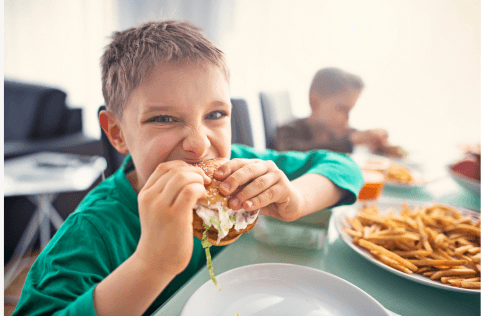What was the messaging around food in your house growing up? Not surprisingly, our relationship with food begins at birth as food is a necessity for survival. Children learn to understand the world as they develop, looking to their parental figures for guidance around how to interact with food.
The messaging that is communicated in the household during childhood plays a significant role in the development of children’s relationship with food well into adulthood. Studies suggest that high levels of critical & restrictive eating messages are associated with decreased levels of intuitive eating (Galloway, Kroon Van Diest, A., and T. Tylka).
In other words, these types of messages begin to create a divide between children’s innate ability to rely on their internal cues to guide food decisions, which could have long term effects on their mental & physical health.
Chances are, you’re reading this because you already have an idea that negative messaging around food is something you want to avoid. But what exactly is “right” and “wrong”? While there is no definitive answer as to what is the most effective way to communicate to your child, these tips can be used as a guide to creating your own language & responses around the dinner table to support a more positive food environment in your house.

the power of food language
Remember - kids are like sponges! As they develop, their brains are taking in everything they can. This is why the language we use to talk about food can be so powerful. It's also why it can be tough to know what to say to help your child build a healthy relationship with food.
All too often we have clients come to us and say something like, "Cheetos are not a healthy choice; I don't have self control if they're around so I can't keep them in the house". This is a seemingly harmless sentence but the phrasing is placing Cheetos in a very negative light. This can have an impact on how you AND your child view and interact with Cheetos.
When we have perceive restriction from anything, whether that is a physical restriction (i.e the food is not in the house or we are not consuming enough throughout the day) OR mental restriction (i.e "I shouldn't have that food) that is an innate desire to crave that food MORE. And typically we then end up eating that food in a way that feels chaotic (or like you have "no self control"). Hint hint - read more about that here. However, when there is neutrality and full permission around foods, you are more likely to eat a wide variety of items.
Think about it like breathing - when you are breathing normally, without thought, your body takes in air at an appropriate rate. However, when you hold your breath (i.e restrict yourself of air) you find that you end us gasping for air when you finally breathe again.
This highlights a NORMAL physiological response to restriction. Your body does not like to be in a state of deprivation and therefore will always try to regulate to ensure that you are NOT deprived.
We understand that, as parents, you only want what is best for your child. And this involves you wanting them to consume foods that will contribute to overall health. And the only way that diet culture has taught us to do that is through fearing and restricting foods. However, in reality, nutrition and holistic health is so much more about the bigger picture:
What are you consuming regularly? Do you have variety in your intake? How are your stress levels? Are you moving in a joyful way? Are you able to emotionally regulate?
ALL of these things contribute to long term, overall health. And the truth is - scrutinizing or curating a negative environment around food may have more long term health implications than having a neutral approach with all foods. Even Cheetos.
Our advice? Buy the Cheetos. Keep them in the house. Treat them like any other snack. Throw them in your child’s lunch. Put Cheetos on the same playing field as fruit or granola bars and I guarantee your child will not choose the Cheetos every single time (though maybe at first, if they’ve been restricted). If exposed to a variety of foods, children will desire a variety of foods.

5 steps to help your child cultivate a positive relationship with food
1. avoid labeling food as good or bad
Placing morals on food can create fear or shame around food for children. Assigning foods as “good” or “bad” can quickly translate to whether they are good or bad for their food choices. Praising some foods while demonizing others teaches lessons to children that eating is only about nutrition & health rather than the many roles food plays including connection, celebration, pleasure, taste & joy.
2. encourage a wide variety of foods
Allow for a plethora of options to be available for children to create an increased sense of autonomy around eating. With different options to choose from, they are given the space to practice tuning into their internal cues. If available to you, try offering a variety of foods from all food groups at meals & snack times. Avoid pressuring children to eat certain foods as this can prevent them from feeling confident in their food decisions or learning about their true preferences around food.
3. discuss food choices as something to explore
Rather than policing the food choices of your children or questioning whether they should have had ‘X’ over ‘Y’, attempt to frame choices as a way to learn about their experiences with different foods. Try to ask probing questions to invite them to be mindful around food such as “what does that food taste like?”, “What textures do you prefer about that food” or “How does that food make you feel?”
4. trust what and how much your child chooses to eat
Avoid setting limitations or restrictions around foods for children. A common practice I hear about is ‘the clean plate club’ at the dinner table, enforcing finishing everything at the meal each night. This can lead to normalizing overriding the body’s internal cues around hunger & fullness, expecting children to eat as much as was served no matter what.
Ellyn Satter, a dietitian & authority on feeding practices in children – writes in her ‘Division of Responsibility of Feeding’ that it is the child’s job to determine whether & how much they eat. As a parent, she states the responsibility is to prepare, provide & model best eating practices.
With children at appropriate ages, trial allowing them to plate & portion their own foods. With younger children, trust when they communicate they are full even if the plate is not clean & avoid comments if they request to have more.
5. invite inclusive language around food and body
Though it may seem harmless or unassuming, the comments we make in passing can have lasting impacts on the impressionable minds of children & adolescents. Making frequent remarks about disliking our body, associating food with perceived negative changes to our body, or judging other people’s bodies or food choices, teaches children that it’s normal to see bodies as something to scrutinize – including their own. Practice using inclusive language such as all foods fit into a nutritious diet or that all bodies are diverse & beautiful.
Most important to note, parenting comes with an endless list of challenges, feeding as just one of the many responsibilities of parenthood. Whether you’d never given it much thought or you feel like you’ve been saying “all the wrong things” – it’s never too late to implement food & body positive language into the household. In addition to these tips, there are incredible resources to continue to learn more about how to talk to your child about food such as ‘How to Raise an Intuitive Eater’ by Amme Severson & Sumner Brooks as well as The Ellyn Satter Institute.

what do i do next?
If you feel your child may be struggling with disordered eating or an eating disorder – consider our Jumpstart to ED for Parents course to better understand the warning signs. Here at NourishRX we are here to support both clients & support systems alike to foster positive relationships with food & body at all stages of the journey.
Additionally, if you feel that your own relationship with food & your body may require more attention to better support a positive food environment in the home, consider 1:1 coaching with our anti-diet, intuitive eating dietitians.
Comments Off on How Do I Talk To My Child About Food? 5 Steps to Cultivating a Positive Relationship with Food